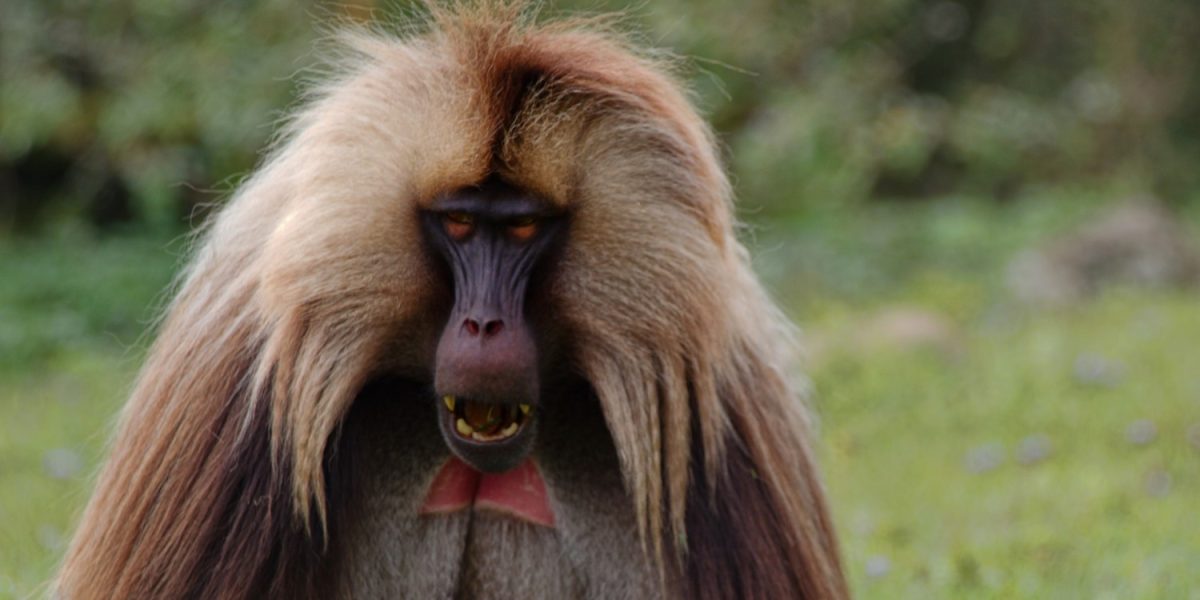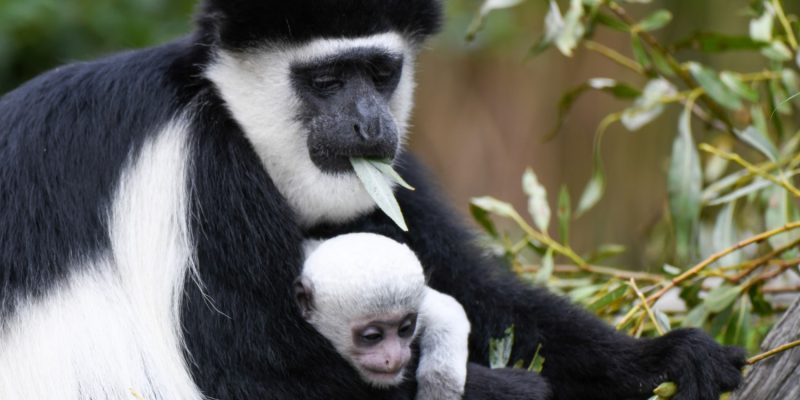
Ethiopia is home to some of the most fascinating and endangered primates in the world. Among them are the geladas, the baboons, and the black-and-white colobus monkeys. These apes have adapted to different habitats and lifestyles, and they offer a glimpse into the diversity and complexity of primate behavior. In this blog post, we will explore the characteristics, ecology, and conservation status of these three groups of apes, and we will also give you some tips on where and how to observe them in the wild. Moreover, we will also suggest some ways that you can learn more about primate behavior, and what kind of resources are available for you to deepen your knowledge and appreciation of these amazing animals.

Geladas are the only living members of the genus Theropithecus, which means “beast-ape” in Greek. They are sometimes called “bleeding-heart monkeys” because of the distinctive red patches on their chests. Geladas are endemic to the highlands of Ethiopia, where they live in large groups of up to 1,200 individuals. They are the only primates that feed primarily on grass, and they spend most of their time on the ground. Geladas have a complex social structure, with multiple levels of hierarchy and affiliation. They communicate with each other using a variety of vocalizations, gestures, and facial expressions. Geladas are also known for their impressive canine teeth, which they use for display and defense.
Geladas are considered to be one of the most intelligent primates, with a brain size comparable to that of chimpanzees. They have been shown to exhibit various forms of learning, memory, problem-solving, tool use, self-awareness, empathy, cooperation, and deception. For example, geladas can learn to associate symbols with numbers or colors, remember the location of hidden food items, solve puzzles to access rewards, use stones to crack nuts or dig tubers, recognize themselves in mirrors or photographs, console distressed group members, coordinate their actions with others to achieve a common goal, or manipulate their social partners to gain an advantage.
If you want to learn more about gelada behavior, you can read some books or articles written by experts who have studied them for years. Some examples are:
– The Gelada Baboon: Status Survey and Conservation Action Plan by N. E. Newton-Fisher et al.
– The Gelada’s Social System: A Review by T. Kawai et al.
– The Evolutionary History and a Systematic Revision of Woodrats of the Neotoma lepida Group by J. R. Michener et al.
– The Social Behavior of Monkeys by S. A. Altmann
– Primate Societies by B. B. Smuts et al.
You can also watch some documentaries or videos online that feature geladas and their behavior. Some examples are:
– Life on the Roof of Africa by BBC
– The Mountains of the Monsoon by BBC
– Planet Earth II: Grasslands by BBC
– Monkey Planet: Meet the Family by BBC
– The Incredible Human Journey: Africa by BBC
Baboons are members of the genus Papio, which includes five species: the hamadryas, the olive, the yellow, the chacma, and the Guinea baboons. Baboons are omnivorous and opportunistic feeders, eating fruits, seeds, roots, insects, small vertebrates, and even crops. They live in troops of varying sizes and compositions, depending on the species and the environment. Baboons are highly intelligent and adaptable animals, capable of learning new skills and exploiting new resources. They also have a rich social life, forming bonds with kin and allies through grooming and other interactions.
Olive baboons in Ethiopia live in every area from the valley floor to the plateau about 2,000 feet above. One possible way to see an olive baboon in Ethiopia is to visit the Simien Mountains National Park, where they are one of the endemic mammals. You can find more information about the park and how to get there on this website: https://simienpark.org/

The Hamadryas baboon’s range extends from the Red Sea in Eritrea to Ethiopia, Djibouti and Somalia. It is also native to the Sarawat Mountains of southwestern Arabia, in both Yemen and Saudi Arabia. It is locally extinct in Egypt. The hamadryas baboon lives in arid areas, savannas, and rocky areas of Ethiopia, especially near the Red Sea and the Awash National Park https://www.protectedplanet.net/652
https://www.tourradar.com/d/awash-national-park
https://www.tripadvisor.com/AttractionProductReview-g293791-d19149194-2_Days_Wildlife_Safari_to_Awash_National_Park-Addis_Ababa.html
https://www.viator.com/tours/Addis-Ababa/Awash-National-Park-Tours/d24099-65512P29
http://extraordinaryethiopiatours.com/awash-national-park/

The yellow baboon (Papio cynocephalus) is a species of primates native to Ethiopia and other parts of Central and East Africa1. You can spot them in savannahs, woodlands, and semi-arid areas21. They are diurnal herbivores3 that live in large social groups1. Yellow baboons are cercopithecinae. They belong to the subfamily of Old World monkeys that includes baboons, macaques, and vervet monkeys1. Yellow baboons have slim bodies with long arms and legs, and yellowish-brown hair23. Do you want to know more about them?
Chacma is Southafrican
Guinea baboon is West african
One possible place to see them in Ethiopia is the Awash National Park, which has a variety of wildlife including yellow baboons, hamadryas baboons, oryxes, kudus, and crocodiles4.
Baboons are also regarded as very smart primates, with a brain size larger than that of most monkeys. They have been shown to exhibit various forms of learning, memory, problem-solving, tool use, self-awareness, empathy, cooperation, and deception. For example , baboons can learn to associate sounds or symbols with objects or actions , remember the identity or rank of group members or strangers , solve tasks involving spatial reasoning or causal inference , use sticks or sponges to access food or water sources that are out of reach or hidden in containers or tubes , recognize themselves in mirrors or photographs , comfort or reconcile with group members after conflicts , cooperate with others to hunt prey or defend against predators , or lie or cheat to obtain food or mates .
If you want to learn more about baboon behavior , you can read some books or articles written by experts who have studied them for years . Some examples are :
– Baboon Metaphysics: The Evolution of a Social Mind by D.L.Cheney et al.
– The Amboseli Baboon Research Project: Forty Years of Continuity and Change by J. Altmann et al.
– The Social Life of Baboons by I. DeVore
– The Baboon in Biomedical Research by J. P. Hearn et al.
– Primate Societies by B. B. Smuts et al.
You can also watch some documentaries or videos online that feature baboons and their behavior . Some examples are :
– Africa’s Wild Horizons: Ethiopia’s Sacred Baboons by National Geographic
– The Life of Mammals: Social Climbers by BBC
– Nature’s Great Events: The Great Migration by BBC
– Monkey Hunters by BBC
– The Incredible Human Journey: Africa by BBC

Black-and-white colobus monkeys are members of the genus Colobus , which includes four species : the Abyssinian , the Angola , the king , and the mantled colobus monkeys . Ethiopia is home to the Abyssinian colobus monkey , which is also known as the guereza . This species has a striking black-and-white coat , with a long white tail that ends in a tuft . Unlike other monkeys , colobus monkeys do not have thumbs , but they have long fingers that help them grasp branches . Colobus monkeys are herbivorous and arboreal , feeding mainly on leaves and fruits in the canopy . They live in groups of about 15 individuals , led by a dominant male . Colobus monkeys are shy and elusive animals , often hiding in dense foliage .
Colobus monkeys are not as well studied as other primates , but they have been shown to exhibit some forms of learning , memory , problem-solving , tool use , self-awareness , empathy , cooperation , and deception . For example , colobus monkeys can learn to associate colors or shapes with rewards or punishments , remember the location or quality of food sources , solve tasks involving object manipulation or numerical discrimination , use leaves or branches as umbrellas or shields against rain or sun , recognize themselves in mirrors or photographs , groom or share food with group members , cooperate with others to defend their territory or resources , or deceive their rivals or predators by hiding or fleeing .
If you want to learn more about colobus monkey behavior, you can read some books or articles written by experts who have studied them for years. Some examples are:
– The Black-and-white Colobus Monkeys: Ecology, Behavior, and Conservation by T.T. Struhsaker et al.
– The Natural History of the African Colobines by J.F. Oates et al.
– The Ecology and Behavior of Black-and-white Colobus Monkeys (Colobus guereza) in the Kakamega Forest, Kenya by P.J. Fashing
– Primate Adaptation and Evolution by J.G. Fleagle
– Primate Societies by B.B. Smuts et al.
You can also watch some documentaries or videos online that feature colobus monkeys and their behavior. Some examples are:
– Wild Africa: Mountains by BBC
– Life: Primates by BBC
– Nature’s Miracle Orphans: Second Chances by BBC
– Monkey Planet: Home Sweet Home by BBC
– The Incredible Human Journey: Africa by BBC
Leave a Reply